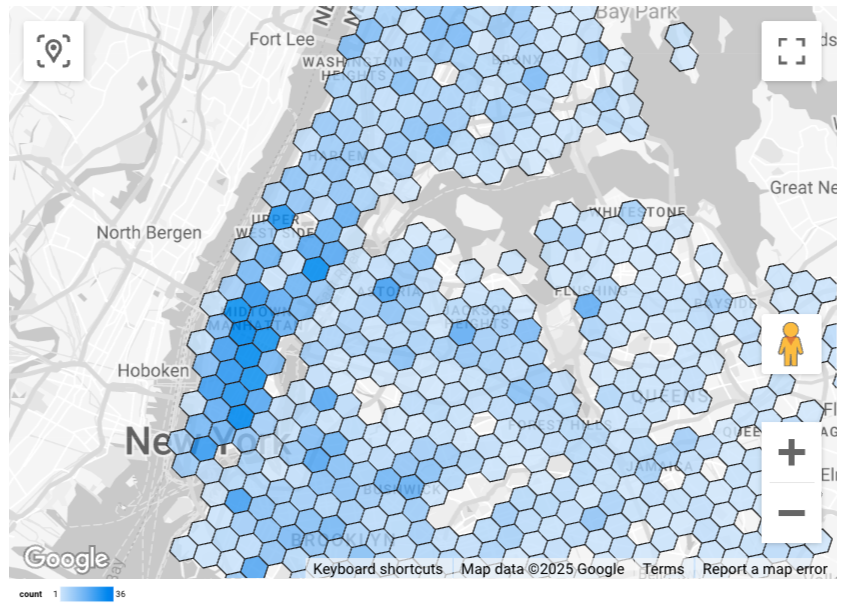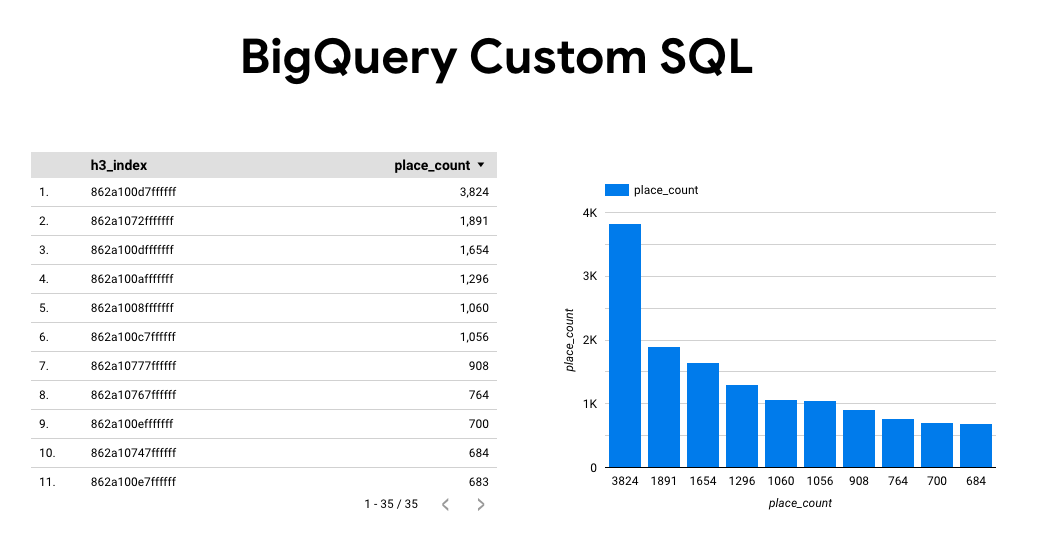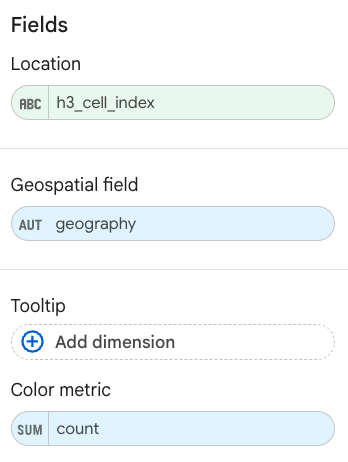Funkcja PLACES_COUNT_PER_H3 przyjmuje obszar geograficzny do wyszukiwania i zwraca tabelę z liczbą miejsc w komórce H3 w obszarze wyszukiwania.
Funkcja PLACES_COUNT_PER_GEO zwraca tabelę, więc wywołaj ją za pomocą klauzuli FROM.
Parametry wejściowe:
Wymagany:
geographyparametr filtra, który określa obszar wyszukiwania. Parametrgeographyma wartość zdefiniowaną przez typ danych BigQueryGEOGRAPHY, który obsługuje punkty, linie i wielokąty.Przykłady użycia różnych typów obszarów geograficznych wyszukiwania, takich jak widoki i linie, znajdziesz w sekcji
PLACES_COUNTfunction.Wymagany:
h3_resolutionparametr filtra, który określa rozdzielczość H3 używaną do agregowania liczby miejsc w każdej komórce H3. Obsługiwane wartości to liczby od 0 do 8.Opcjonalnie: dodatkowe parametry filtra, które pozwalają zawęzić wyszukiwanie.
Zwraca:
- Tabela z jednym wierszem na komórkę H3. Tabela zawiera kolumny
h3_cell_index(STRING),geography(GEOGRAPHY), która definiuje wielokąt reprezentujący komórkę H3,count(INT64) iplace_ids(ARRAY<STRING>), gdzieplace_idszawiera maksymalnie 250 identyfikatorów miejsc dla każdej komórki H3.
- Tabela z jednym wierszem na komórkę H3. Tabela zawiera kolumny
Przykład: zliczanie sklepów ogólnospożywczych i spożywczych z dostępem dla osób na wózkach inwalidzkich w każdej komórce H3
Poniższy przykład oblicza liczbę działających sklepów spożywczych i ogólnospożywczych przystosowanych do potrzeb osób na wózkach inwalidzkich w poszczególnych komórkach H3 w Nowym Jorku. Komórki H3 mają poziom rozdzielczości 8.
W tym przykładzie używamy publicznego zbioru danych BigQuery Overture Maps Data, aby uzyskać dane geograficzne Nowego Jorku.
DECLARE geo GEOGRAPHY; -- Get the geography for New York City. SET geo = (SELECT geometry FROM `bigquery-public-data.overture_maps.division_area` WHERE country = 'US' AND names.primary = 'City of New York' LIMIT 1); SELECT * FROM `PROJECT_NAME.places_insights___us.PLACES_COUNT_PER_H3`( JSON_OBJECT( 'geography', geo, 'types', ["convenience_store","grocery_store"], 'wheelchair_accessible_entrance', true, 'business_status', ['OPERATIONAL'], 'h3_resolution', 8 ) );
Odpowiedź funkcji:

Wizualizacja wyników
Na poniższych obrazach te dane są wyświetlane w Looker Studio jako mapa wypełniona. Im ciemniejsza komórka H3, tym większe zagęszczenie wyników:

Aby zaimportować dane do Looker Studio:
Uruchom powyższą funkcję, aby wygenerować wyniki.
W wynikach BigQuery kliknij Otwórz w –> Looker Studio. Wyniki są automatycznie importowane do Looker Studio.
Looker Studio tworzy domyślną stronę raportu i inicjuje ją za pomocą tytułu, tabeli i wykresu słupkowego wyników.

Zaznacz wszystko na stronie i usuń.
Aby dodać do raportu mapę wypełnioną, kliknij Wstaw –> Mapa wypełniona.
W sekcji Typy wykresów –> Konfiguracja skonfiguruj pola w sposób pokazany poniżej:

Wypełniona mapa będzie wyglądać jak powyżej. Opcjonalnie możesz kliknąć Typy wykresów –> Style, aby dodatkowo skonfigurować wygląd mapy.
Więcej informacji i przykłady wizualizacji wyników Places Insights znajdziesz w artykule Wizualizacja wyników zapytania.

